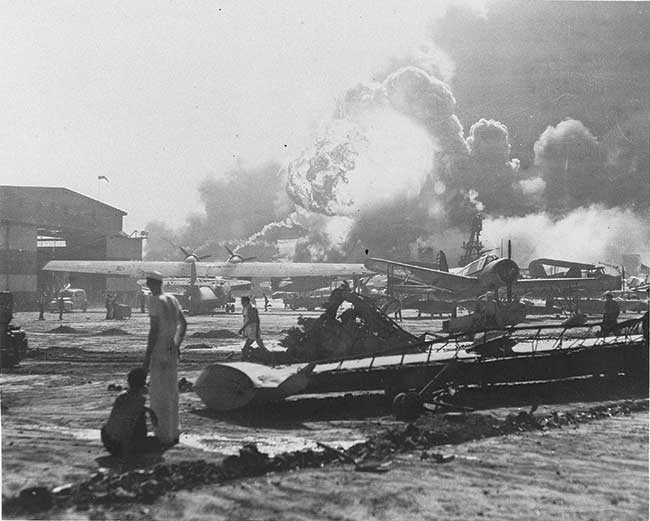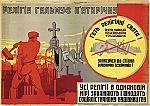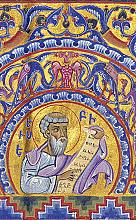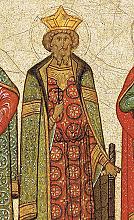Surprised by Christ

[Unknown photographer, Damage at Pearl Harbor, Hawaii from Japanese attack, December 7, 1941—National Archives and Records Administration / Public domain, Wikimedia]
In an age we often remember for its darkness, these fascinating figures pointed to God’s unfailing light.
A reluctant convert
C. S. Lewis (1898–1963) was born into a bookish family of Protestants in Belfast, Ireland, on November 29, 1898. As a young boy, Lewis inhabited an imaginary world of “dressed animals” and “knights in armor”—more so as his elder brother, Warren, went to boarding school in 1905 and when his mother died from cancer in 1908.
The death of Flora Lewis convinced young Jack that the God he encountered in church and in the Bible his mother gave him was, if not cruel, at least a vague abstraction—in his early teens, Lewis became an atheist.
In 1914 Lewis was sent to Great Bookham, Surrey, where W. T. Kirkpatrick, a brilliant teacher and friend of Lewis’s father, tutored him. Kirkpatrick initiated Lewis into the world of the Greek and Latin authors—in the original languages—launching him into lifelong skills of critique, analysis, and clear thinking and writing.
Lewis entered the world of Oxford in 1917 as a student, and he never really left. Despite an interruption to fight in World War I and his professorship at Cambridge beginning in 1954, he always maintained his home and friends in Oxford. He loved the bookshops, the pubs, and the Bodleian Library, and he reveled in the company of local men who loved to read, write, and discuss books.
By 1924 Lewis was a philosophy tutor at University College, and the following year he was elected a Fellow of Magdalen College, where he tutored in English language and literature. Oxford brought Lewis both a career and a close circle of friends. He would later say repeatedly that over half of human happiness comes from friendship. In his early years at Oxford, he began reading books that later led him to say, “A young man who wishes to remain a sound atheist cannot be too careful of his reading.” And once he met Owen Barfield, Neville Coghill, Hugo Dyson, and J. R. R. Tolkien, the die was cast: slowly but surely Lewis moved from atheism into belief in God, and then, by 1929 or 1930, full-blown Christian faith.
Between 1933 and his death in 1963, C. S. Lewis wrote such popular books as the seven-volume Chronicles of Narnia, The Screwtape Letters, The Great Divorce, and Mere Christianity. They nudged atheists and agnostics toward the faith and encouraged and nurtured believers.
Through these works, letters, and lifelong charity to the needy, Lewis lived out one of his deepest convictions: “There are no ordinary people. You have never talked to a mere mortal.” He followed this conviction through wartime sermons and radio talks, and through answering countless letters from fellow immortals seeking spiritual advice, until nearly the day he passed to his eternal reward on November 22, 1963.
Today the life and work of this spiritual pilgrim and literary scholar still speak to the many thousands around the world walking their own spiritual pilgrimages. —Lyle W. Dorsett, from CH #7
An unlikely evangelist
Commander Mitsuo Fuchida (1902–1976) of the Imperial Japanese Navy Air Service led the first wave of bomber and fighter planes during Japan’s attack on Pearl Harbor. At 7:40 a.m. on December 7, 1941, he sent up the green flare from his plane signaling the order to attack. He later ordered his radio operator to send the message “Tora! Tora! Tora!” informing the Japanese that they had achieved complete surprise. The attack on the Hawaiian US Navy base resulted in 2,403 American and 64 Japanese deaths. The following day the United States officially declared war on Japan and entered World War II.
Fuchida served Japan throughout the war. During the conflict, he repeatedly escaped death—from missing a flight run during the Battle of Midway owing to an emergency appendectomy, to being thrown by an explosion that broke both ankles, to being ordered to Tokyo just before his superior, Vice Admiral Kakuji Kakuta, failed to stop the American liberation of Guam (had he been with Kakuta, he would have participated with the vice admiral in suicide by seppuku).
Fuchida was also due to be in Hiroshima when the atomic bomb was dropped on August 6—but at the last minute, he was sent instead to another city. In the bomb’s aftermath, he was part of the team that inspected Hiroshima—and he was the only man with them not to die of radiation poisoning. He later recalled that life seemed futile after the war: “I had missed death so many times and for what? What did it all mean?”
Later, called on to testify in war crimes trials related to Japanese treatment of prisoners of war, Fuchida felt the trials were a sham. For decades he had harbored resentment of the Americans because of their own poor treatment of POWs and their severe restrictions on Asian immigration. So he sought out recently released POWs to gather evidence.
Among these prisoners he met former flight engineer Kazuo Kanegasaki. Rather than the expected story of abuse and torture by Americans, Kanegasaki instead told Fuchida of a young American woman, Peggy Covell, who, despite the slaying of her missionary parents by Japanese soldiers, treated him and his fellow prisoners with kindness. Fuchida was astounded. The code of the warrior demanded revenge, but this woman declined it, offering compassion to Japanese prisoners instead.
This sparked Fuchida’s interest in Christianity. He encountered the testimony of Jacob DeShazer, an American POW who had found God in a Japanese camp. Deeply moved by his story, Fuchida became a Christian. “Looking back,” he said later, “I can see now the Lord had laid his hand upon me so that I might serve him.”
Fuchida established an evangelistic association, traveling to share a presentation of his conversion story. In his autobiography, From Pearl Harbor to Calvary (1959), he wrote, “I remember the thrill that was mine when, in one of my first meetings, I led my first soul to Christ in America. And he was one of my own countrymen.”
Fuchida authored a number of books, including the autobiography and an account of the Battle of Midway. He died in Japan at age 73. —Matt Forster, from CH #121
A heart belonging to Jesus
On Christmas Eve in 1985, a petite Albanian nun stood before microphones and cameras at St. Veronica’s Church in New York City’s Greenwich Village and spoke: “We want that nobody dies unloved and uncared for. We are hoping that they will be able to live and die in peace by getting tender love and care.” She added, “Because Jesus was also born, so I wanted to help them to be born in joy and love and peace.” The nun, Mother Teresa, was at the opening of a hospice home for those dying of AIDS during the height of that epidemic. She established many such houses throughout her life.
Born Anjezë (Agnes) Gonxha Bojaxhiu (1910–1997), Mother Teresa grew up in the present-day Macedonian capital of Skopje. When she was young, her father died, leaving her mother alone with Agnes and two other siblings. Their strong Catholic faith carried them through the tragedy; even with little to spare, Agnes’s mother impressed a deep sense of generosity on her children, inviting the city’s destitute to share the family’s food.
At 12 young Agnes felt a call to religious life. She left six years later to join the Sisters of Loreto in Ireland, where she took the name Sister Mary Teresa. During her novitiate period, she went to Darjeeling, India, and after her first profession of vows, to Calcutta. She learned Bengali and Hindi and taught in a convent-run girls’ school for the city’s poorest.
At 36 Teresa heard Christ commanding her to care for Calcutta’s neediest. After six months of medical training, she got to work among the forgotten, sick, and dying poor. Soon she established the Missionaries of Charity and founded homes and health clinics for Calcutta’s poor, including a leper colony.
In 1969 Malcolm Muggeridge’s BBC documentary Something Beautiful for God catapulted Mother Teresa and her charitable work from obscurity to world renown; in 1979 she received the Nobel Peace Prize. Donations also poured in to the Missionaries of Charity. By her death in 1997, over a hundred countries and thousands of missionaries and lay volunteers had joined the Missionaries of Charity, caring for the homeless, the disabled, refugees, lepers, and victims of HIV/AIDS.
With renown came controversy. Her traditional Catholic opposition to abortion and contraception drew the ire of secular critics; her interest in conversion provoked prominent Hindus; and some conservative Christians saw her as a universalist. Antitheist Christopher Hitchens claimed she had exacerbated institutionalized poverty, accepted the money of dictators to further her religion, and provided subpar medical care.
For her part Mother Teresa struggled with doubt. In the end she reconciled her legacy in this way:
By blood, I am Albanian. By citizenship, an Indian. By faith, I am a Catholic nun. As to my calling, I belong to the world. As to my heart, I belong entirely to the Heart of Jesus. —Kaylena Radcliff, from CH #135 CH
By Lyle W. Dorsett, Matt Forster, Kaylena Radcliff
[Christian History originally published this article in Christian History Issue #150 in 2024]
Lyle W. Dorsett is an author and was the second director of the Marion E. Wade Center at Wheaton College, serving from 1983 to 1990. Matt Forster is a communications professional and freelance writer. Kaylena Radcliff is managing editor of CH and has been with VV/CHI since 2012.Next articles
Russian Christianity and the revolution: what happened?
The sins of the church came back on its head with a fury
Andrew SorokowskiRecommended resources: Stories worth retelling
We covered a lot of ground in this issue of CH! Here are just a few resources we recommend to learn more.
the authors and editorsSupport us
Christian History Institute (CHI) is a non-profit Pennsylvania corporation founded in 1982. Your donations support the continuation of this ministry
Donate







